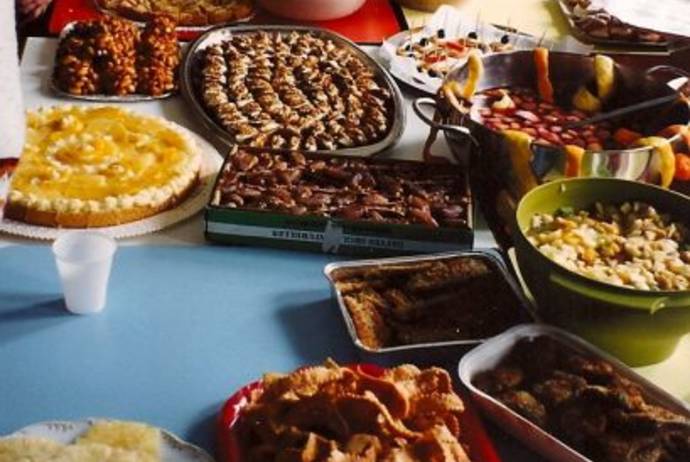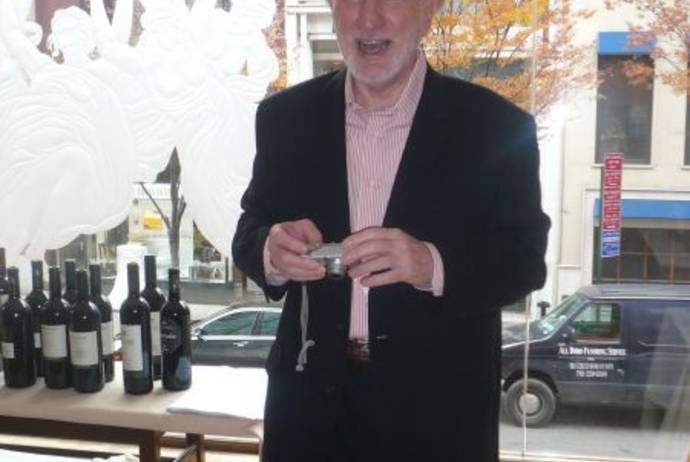Wine Media Guild Tasting and Luncheon
The Wine Media Guild (www.winemediaguild.com) is an association of wine communicators dedicated to providing wine information and education. Each month a wine tasting and luncheon is held at Felidia restaurant in
Manhattan. The November 5th event was a tasting of the wines of
Puglia. I was the guest speaker and here are some of my remarks on wine making in
Puglia.
Like most of Southern Italy, the Phoenicians and the Greeks taught the people of
Apulia (Latin name) how to cultivate the vine (viniculture).
When the Roman Emperor Augustus divided Italy into eleven regions, Apulia was one of them, but at that time it also included Calabria and part of Campania (
Sorrento).
The Latin derivation of
Apulia (A-Pluvia) was not in the sense of lacking rain but as the Roman poet Horace used it, a land “dry and parched”. Horace mentions the red wines of
Apulia in his writings and was very fond of them. Pliny the Elder (d 79AD) in his Natural History says that the wines of Apulia were as good as the highly praised Falerno from
Campania. The wines were made from black grapes and had high alcohol content.
Apulia was a crossroads of civilization during the Middle Ages, especially during the Norman period 1078 -1250, a golden age. Basilian monks kept viniculture alive, though wine growing in
Puglia would not improve until well into the 20th century.
Beginning in the late 18th Century, France and Northern Italy began to look to
Puglia as a source to strengthen their wine. This continued into the 19th and 20th Centuries. Puglia became even more important to France after it lost
Algeria in the 1950’s. The wines of Puglia were perfect for strengthening the wines of
Northern Europe and for making vermouth.
Growers in
Puglia picked the grapes late (high sugar) and used growing methods to increase grape yields. They got what they wanted: high production and high alcohol and were not interested in making quality wines. In fact, most of the growers believed that they could not, given the conditions for wine growing in
Puglia. It was easier to produce grapes in this way and sell them in bulk.
Puglia also is a big producer of table grapes and some of these were being used for wine.
Italian enologists gave up on Puglia and considered
Apulia unsuitable to produce quality wines because the grapes had too much alcohol; the region had too much heat and wind (sirocco).
Puglia produces more wine than
Australia. In Italy, it is second to the Veneto in total production and second to
Sicily in the number of vines planted. Although there is a sea of wine in
Puglia, people there drink more beer than wine.
Puglia does not have a wine culture. Only 35% of the wine produced in the region is consumed there. Until recently the locals did not consider their wine to be special. This attitude began to change slowly. One of the turning points was when the Candido winery hired Severino Garofano from the Scuola di Enologia in 1957. Candido was making good wine but wanted to improve the quality and they felt Garofano could make a difference, and he did. Not only did he improve the wines at Candido but went on to consult for many wineries in southern
Puglia. Today he is considered one of the top enologists in
Italy.
Leone di Castris, founded in 1661, may be the oldest winery in
Puglia. Their “Four Roses Rosato” is thought to be the first rosato made in
Italy. Today they have a very modern winery with a state of the art tasting room.
Cosimo Taurino winery was founded in the 1970’s. For a number of years they were the only wines from Puglia one could get on regular basis in the
U.S.
Rivera Winery in the Castel del Monte area has been making very good wines for a number of years.
Accademia dei Racemi wines were launched in 1999 at Vinitaly. They are a modern winery but went back to the traditional way of training the vines the Alberebllo method (bush trained vines).
These were some of the wineries that understood that quality wine could be made in
Puglia.
Foreigners began to see the untapped potential of
Puglia. Kendall Jackson (U.S), Feudi di San Gregoria (Campania), Calatrasi (Sicily) , Avignonesi (
Tuscany) have investments here. The most famous perhaps is Piero Antinori of Tuscany who makes wine in
Puglia under the Tormaresca label.
Here are my comments on the tasting:
There were 35 wines from the different regions of
Puglia. I am the co-chair of the Wine Media Guild and my co-chair is Pat Savoie. It was my honor to be the speaker at this event. I was introduced by Jeremy Parzen (see his blog on the event www.dobianchi.com (Nov. 12, 08). Jeremy helped to get many of the wines for the event and invited Francesca Mancarella, the export director for the Candido winery, and Gary Gunnner the
USA brand manger for Candido wines to the tasting. The wines of Candido are not imported at the present time. However I have been to the winery and liked the wines. Gary and Francesca were kind enough to bring samples to the tasting.
It was a very impressive tasting and my co-chair and I agreed that we liked 95% of the wines.
Puglia is not known for its white wines but the Gravina Bianco 2007 from Botomango, (60% Greco and 40% Malvasia) was light, fruity, with a hint of pear ($ 11). It was the favorite white wine.
The Five Roses Rose 2007 from Leone de Castris (90% Negroamaro and 10% Malvasia ) had a strawberry flavor and was very balanced ($18 ). It is one of the oldest wineries in
Puglia but the facilities are very up to date. In fact it has the best tasting rooms that I have ever been in.
Il Falcone Riserva 2003 from Rivera $26 (70% Nero di Troia and 30% Montepulicano) was one of the most elegant wines at the tasting. It was very well balanced, with good fruit, acidity and a pleasing after taste.
There were a few red wines that I believe were great values:
Vigna Flaminio Riserva 2007 Vallone $15 (70% Negroamaro and 20% Montpulciano 10% Malvasia Nera).
Salice Salentino (80% Negroamaro and 20% Malvasia Nera, $15
and the Notarpanaro (Negroamaro)$20 both from Taurino.
The Cappllaccio Aglianico Riserva 2003 Rivera (100% Aglianico)
($18).
I had never had a 100% Syrah from
Puglia. The Suahili from Vignamaggio aged in botti (large oak barrels) was very good and a bargain at $13.
Piero Antinori now makes wine in
Puglia under the Tormaresca label. Bocca di Lupo 2004 (100% Aglianico) $38 is a modern style wine with more than a hint of oak. However, I found it to be very well made and a good wine of this type. It was the number two wine in a tasting of Aglianico in Eric Asimov’s column in the Times on September 17, 2008 at which I was a member of the tasting panel.
The 1999 Patriglione from Taurino (90 % Negroamaro and 10 %Malvasia Nera) $70 may have been the top wine of the tasting as every one was trying to take it to their table to drink with lunch. The grapes are late harvested. It has prune-like aromas and flavors with good acidity. It has a long finish and lingering aftertaste.
Gratticiaia 2003 from Vallone (100% Negroamaro) $70. The grapes are dried for three weeks in the hot Puglian sun. It is a big wine with deep prune aromas and flavors.
There were two desert wines the Moscato di Trani “Piani di Tufara” 2004 Rivera (375)$ 20
and the Aleatico 2002 from Candido. The Moscato was very pleasant with hints of pear and apricot and not too heavy. The Aleatico was aromatic with undertones of red fruit and good acidity.
Unfortunately I was unable to have the old style Primitivo at the tasting that I wanted, an omission noted by Paul Zimmerman. There was also a discussion of the origin of Primitvo, which is a very interesting topic. Everyone agrees that the grape originated in
Croatia,
that it is related to Zinfandel, but when and how it came to
Puglia is a matter of debate. Terry Robards agreed with me on the origin of the grape and when and how it came to
Puglia. For Terry’s comments see Robert Simonson www.offthepresses.com 11 - 2008
Peter Hellman asked his usual question on barriques and did mention “The Dark Side” (wines the have too much oak aging).
A few nights ago I had the Cappello di Prete (Negroamaro) 2004 from Candido. It had black cherry and licorice aromas and flavors and was a perfect combination with the roast lamb we had for dinner. The wine was much better with food then on its own. This just goes to prove some wines need food in order to be at their best.
Next time a tasting of Tuscan wines in
Siena




































 inished pie.
inished pie.
 d they would not bake properly.
d they would not bake properly.






 Giacomo Moretti of the Associazione Enologi e Enotecnici italiani
Giacomo Moretti of the Associazione Enologi e Enotecnici italiani


